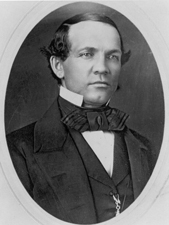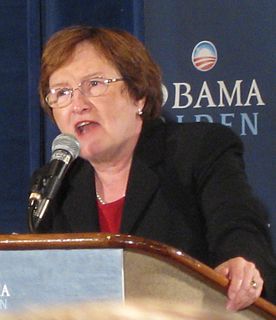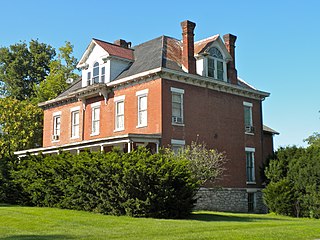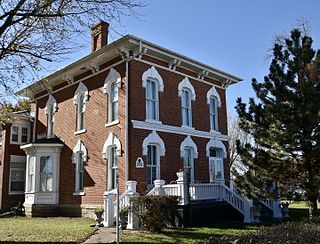
Charles Edward Stuart was a U.S. Representative and U.S. Senator from the state of Michigan.

Patty Jean Poole Judge is an American politician who served as the 45th Lieutenant Governor of Iowa from 2007 to 2011 and previously the 13th Secretary of Agriculture of Iowa from 1999 to 2007. She unsuccessfully ran for reelection as Lieutenant Governor in 2010 after being elected to the office in 2006 with Chet Culver as Governor.

The Robert H. Sunday House is located in Marshalltown, Iowa, United States. It was designed by Frank Lloyd Wright in the Usonian style, and was listed on the National Register of Historic Places in 1988. Initially the Sunday's choose the Usonian Automatic, a natural concrete block model, for their home. When it provided unworkable, Wright sent the plans for this house. In style and materials it is very similar to the 1953 Usonian Exhibition House. It was the sixth of seven houses designed by Wright and built in this style in Iowa. Sunday, who owned Marshall Lumber in Marshalltown, acted as his own general contractor. In fact, he and his wife did much of the work themselves. It is also believed to be last of this style built in brick. John H. Howe, a Wright assistant who supervised the initial construction, designed an addition to this house in 1970 that conforms seamlessly with the original. It includes the family room, family room terrace, and the dining room. The original house followed an "L" shaped plan, and with the addition it is now a "T" shaped plan. Howe had previously designed (1964) the building for Sunday's business.

Democrat Building is a historic building located in downtown Davenport, Iowa, United States. It was listed on the National Register of Historic Places in 1983. The historic newspaper building is now an apartment building known as The Democrat Lofts.

The John N. and Mary L. (Rankin) Irwin House is a historic building located in Keokuk, Iowa, United States. It was individually listed on the National Register of Historic Places in 1999. In 2002 it was included as a contributing property in The Park Place-Grand Avenue Residential District.
Kendall House may refer to:

The Adlai E. Stevenson II Farm, also known as Adlai E. Stevenson Historic Home is a historic property located on St. Mary's Road in Mettawa, Illinois. Between 1936 and his death it was the home of Adlai Stevenson II (1900-1965), a Democratic politician who was the governor of Illinois between 1949 and 1953, was twice the Democratic Party's presidential candidate in the 1950s and served as the US ambassador to the United Nations during the Cuban Missile Crisis in October 1962. The farm was listed on the National Register of Historic Places and has also been designated a National Historic Landmark. The property is located in the northern suburbs of Chicago, in the Captain Daniel Wright Woods Forest Preserve. It currently functions as a museum.

The Lewis Steward House is a historic residence in Plano, Illinois. It was the home of Lewis Steward, a prominent early settler to Kendall County who co-founded Marsh, Steward & Company, ran for the governorship of Illinois, and was elected to the United States House of Representatives.

The Jonathan Clark Conger House is a historic house museum located at 903 East Washington Street in Washington, Iowa.

The Dr. George A. Jenkins House is a historic house located at 223 South C Street in Albia, Iowa.

The Elbert-Bates House is a historical residence located in Albia, Iowa, United States. The house is named for two of its earlier owners. Benjamin F. Elbert was Cashier and member of the board of directors of the First National Bank of Albia, as well as a capitalist farmer who specialized in cattle. He relocated to Des Moines where he was a successful businessman. David W. Bates was a local attorney and banker. He went to serve as the Iowa State Superintendent of Banking during the Great Depression. Elbert had the original house built from 1873 to 1875. Bates had the two-story Prairie Style-influenced solarium built onto the rear of the house from 1917 to 1918. The house originally had a wooden porch on the front, but because of extensive wood rot it was removed at the same time the solarium was added.

The T.B. Perry House is a historical residence located in Albia, Iowa, United States. Theodore Perry was a local attorney and businessman who served two terms in the Iowa Senate. He is also responsible for a couple of buildings in the Albia Square and Central Commercial Historic District. This house is a High Victorian eclectic style structure. It is one of four large brick houses in Albia known as the Four Sisters. They all feature a running brick bond on their exterior walls. It is an unusual architectural feature for southern Iowa in the period they were built, and it also suggests they have the same architect and/or brick mason. The Elbert-Bates House is another house in this group. The Perry house was designed by Charles A. Dunham from the prominent Burlington, Iowa architectural firm of Dunham & Jordan. It is noteworthy for its elaborate roofing system. It features five dormer windows, two hip-and-deck roofs, three gable roofs, and two hipped roofs. The steeply pitched roof also has finials, pendants, and brackets with a modified frieze under the eaves. Other elements of the richly ornamented exterior include barge boards on the second story and entry gables, and a front porch with Gothic tracery millwork. The house was listed on the National Register of Historic Places in 1983.

The Perrigo-Holmes House is a historic residence located in Boone, Iowa, United States. Joel C. Perrigo was a Vermont native who worked for several different railroads, including the Chicago and North Western, which probably brought him to Boone. He also had extensive land holdings in the county. Adoniram J. Holmes was a local attorney who was elected the mayor of Boone before being elected to the United States House of Representatives as a Republican. He represented Iowa's 10th congressional district before serving as the Sergeant at Arms of the United States House of Representatives. He and his wife Emma bought the house right after he was elected to congress. Perrigo had the two-story, frame high-style Italianate house built around 1871. The "L" shaped structure features paired brackets under the eaves, and the front porch is located in the inside angle. A barn, believed to be a contemporary of the house, is also part of historic listing. It is one of a few town barns left in Boone. The house was listed on the National Register of Historic Places in 1994.

The A. J. Stephens House, also known as the Carpenter House and the Lucas County Historical Society Museum, is a historic building located in Chariton, Iowa, United States. The two-story concrete block structure was built by Stephens as his family's home in 1908. He was a local contractor and the house was a showcase for masonry products and his skill in using them. The house is a larger version of the American Foursquare. On the front is a two-story Neoclassical style porch. The Lucas County Historical Society bought the house in 1966 for use as a museum. The house was listed on the National Register of Historic Places in 1987.
Josiah Titus Young was an American newspaper editor and politician.

The Garland House is a historic building located in Dubuque, Iowa, United States. Joseph C. Garland settled in Dubuque in 1889 and built a general insurance agency that grew to cover 25 counties in Iowa representing the Northwestern Mutual Life Insurance Company. He was also a community booster and philanthropist. The exterior of his large Georgian Revival home is covered with concrete block veneer, which is an unusual combination. The main facade is dominated by a two-story pedimented portico, the east elevation by a centered semicircular vault dormer, and the rear elevation by a two-story veranda. The house is capped with a hip roof with dormers. It was individually listed on the National Register of Historic Places in 1983, and it was included as a contributing property in the Langworthy Historic District in 2004.

The Kirkwood House is a historic building located in Iowa City, Iowa, United States. It was built for local attorney and businessman Samuel J. Kirkwood who also served as Governor of Iowa, represented Iowa in the United States Senate, and was Secretary of the Interior in the cabinet of President James A. Garfield. The house was built after his second term as governor and remained his home until his death in 1893. His widow remained here until her death in 1923. This was his home during most of his political career and it reflects the "rural and unpretentious style of living" that the Kirkwood's preferred. The house was originally located on a much larger estate, but the rest of it has subsequently been divided into lots and sold. The two-story L-shaped wood frame structure, which sits further back from the street than other houses on the block, has paired brackets and a roof line cornice as its only ornamentation. The house was listed on the National Register of Historic Places in 1974.
Theodore Bolivar Perry was an American lawyer and politician who served in the Iowa State Senate and as prosecuting attorney of Monroe County, Iowa.





















